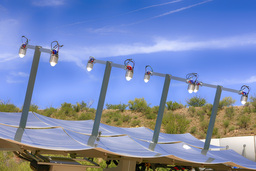Plasmonic Multicomponent Aerogels for Solar Thermal Applications
TECHNOLOGY NUMBER: 2019-184
Tags:

OVERVIEW
Thermally insulating, optically transparent silica aerogel that is stable at elevated temperatures (>600 degrees Celsius)- Solar receivers utilizing this material generate 700 degrees Celsius at low concentration ratio
- Increases efficiency of CST system by 6-10% at nominal extra cost, reduces LCOE by 25-35%
BACKGROUND
The market for concentrated solar thermal (CST) technologies in 2018 was $5.5 billion and expected to grow at CAGR of 38% through 2023. To be truly competitive with coal and natural gas energy sources, next-generation CST plants are required that will utilize enhanced solar receivers to reach even higher temperatures (> 600 degrees Celsius) for efficient generation of carbon-neutral electricity or to provide high-temperature industrial process heat. Such elevated temperatures are desirable for CST plants because they may enable the use of supercritical CO2 power cycles that have higher thermodynamic efficiency than the current steam cycles. Moreover, up to 53% of industrial process heating requires temperatures over 600 degrees Celsius. Together, these two demands account for over 45% of our current energy use.
To reach temperatures above 600 degrees Celsius, solar receivers must absorb solar irradiation while losing minimal amounts of heat energy as infrared radiation. Silica aerogels have been explored previously for use as a thermal insulators in solar receivers. However, at these elevated temperatures silica aerogels are insufficient as they become less insulating and less stable.
INNOVATION
Technology developed at the University of Michigan uses a special deposition process to create a multicomponent silica aerogel that is transparent to solar radiation (>93%), is thermally stable at 700 degrees Celsius, and exhibits suppressed radiative heat loss compared to conventional silica aerogels. Solar receivers utilizing this material generate 700 degrees Celsius at low solar concentration ratio (< 90x) and with a collection efficiency exceeding 64%. Because the increased efficiency comes at nominal extra cost, this technology has been projected to decrease the levelized cost of electricity (LCOE) by 25-35%.
The high operating temperature of this multicomponent silica aerogel enables the use of alternative heat transport fluids such as supercritical CO2, which may further increase the efficiency of the solar thermal plant. Additionally, the material does not require the vacuum environment that traditional receivers do. Being able to operate under nitrogen or even air increases the life span of the receiver and decreases the maintenance required, which significantly reduces the lifetime cost of the solar installation.
The technology is best suited for use in moderate intensity solar thermal systems, meaning those that concentrate to 3-80 suns. Examples are line-focused systems, such as parabolic trough designs. The insulator material could potentially also have application in high performance insulation and window materials.